Mega Archive: Part I: From Space Harrier II to The Revenge of Shinobi
By Mento 0 Comments
Now that the quiet summertime has rolled around, the Giant Bomb wiki's had its fancy new update, and people are talking about the Mega Drive again after a recent (if slightly flawed) retro compilation release, I figured it was time to make yet another effort to extend an olive branch to the "other side" of the 16-bit rivalry that defined my childhood, or at least made for a colorful backdrop against all that homework I should've been doing. Unlike the SNES, which I was very familiar with before starting its Wiki Project, and the TurboGrafx-16, which I was not at all familiar with until its Wiki Project (and the TurboMento/Octurbo features from a few years prior), my knowledge of the Mega Drive is substantial but far from complete. It's the third and final part of the 16-bit trifecta, most importantly, so it was inevitable I'd get around to working on its pages eventually.
Same as previous Wiki Projects, I intend to ensure all the release data is up to date, that each page has a moderate amount of descriptive text in its main body, and that they all have a snazzy .PNG for its background "header" image as well as any alternative title screens from different regions. I'm also chronicling them all in this fortnightly feature for posterity, with all the statistics you could want. I'm going to try to do 20 each episode, for a total of 300 by the end of the year, which isn't as many as it sounds - it helps that most of Sega Mega Drive games have a lot of coverage on the site already, so it's just going to be the weird Japan-only types that'll give me any trouble.
Before we start, I just want to highlight Dr. Sparkle's Chronsega video series (especially the last two videos, Episode 8 and Episode 9, which is when it started covering Mega Drive games) and Player One Podcast's Generation 16, which are both excellent video documentaries that cover Mega Drive games in chronological order. I learned a lot from both.
Mega Archives from the Future:
- Part I: 001-020 can be found... well, right here on this webpage.
- Part II: 021-035 can be found here.
- Part III: 036-050 can be found here.
- Part IV: 051-065 can be found here.
- Part V: 066-080 can be found here.
- Part VI: 081-098 can be found here.
- Part VII: 099-115 can be found here.
- Part VIII: 116-130 can be found here.
- Part IX: 131-145 can be found here.
- Part X: 146-160 can be found here.
- Part XI: 161-175 can be found here.
- Part XII: 176-190 can be found here.
- Part XIII: 191-205 can be found here.
- Part XIV: 206-220 can be found here.
- Part XV: 221-240 can be found here.
- Part XVI: 241-255 can be found here.
- Part XVII: 256-270 can be found here.
- Part XVIII: 271-285 can be found here.
- Part XIX: 286-300 can be found here.
- Part XX: 301-310 can be found here.
- Part XXI: 311-320 can be found here.
- Part XXII: 321-330 can be found here.
- Part XXIII: 331-340 can be found here.
- Part XXIV: 341-350 can be found here.
- Part XXV: 351-360 can be found here.
- Part XXVI: 361-370 can be found here.
- Part XXVII: 371-381 can be found here.
- Part XXVIII: 382-390 can be found here.
- Part XXIX: 391-400 can be found here.
- Part XXX: 401-410 can be found here.
- Part XXXI: 411-420 can be found here.
- Part XXXII: 421-430 can be found here.
- Part XXXIII: 431-440 can be found here.
And here's entries for the companion series, Mega Archive CD:
- CD Part I: 1-11 can be found here.
- CD Part II: 12-20 can be found here.
- CD Part III: 21-29 can be found here.
- CD Part IV: 30-37 can be found here.
- CD Part V: 38-49 can be found here.
And I've also started a spreadsheet to make it easier to find older Mega Archive entries and specific games: it's this one right here.
Part 1: 001-020 (October 1988 - December 1989)
001: Space Harrier II
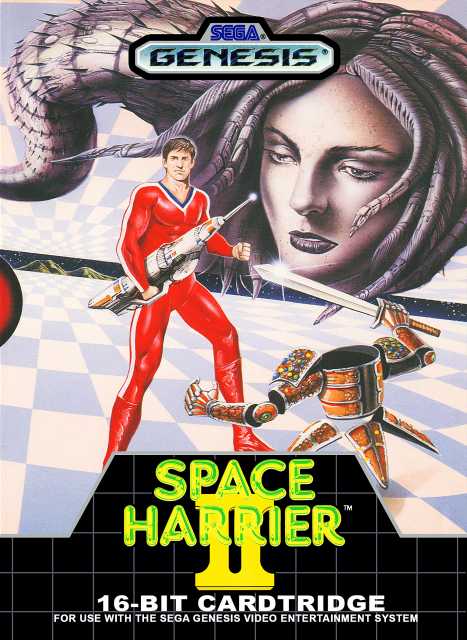
- Developer: Sega
- Publisher: Sega
- JP Release: 10/29/1988
- NA Release: 08/14/1989
- EU Release: 1990
- Franchise: Space Harrier
- Genre: Shoot 'em up (Z-Axis)
- Theme: It's called the Fantasy Zone for a reason! (It's sci-fi.)
- Premise: In the distant future, Harrier is called upon to rescue the Fantasy Zone from invading enemies once again.
- Availability: Released on Sega Ages 2500 Series Vol. 20: Space Harrier II ~Space Harrier Complete Collection~ (JP only) in 2005, on Wii Virtual Console in 2006, on iOS in 2010, and on the Sega Genesis Classics compilation in 2010 (Steam, in Vol. 1) and 2018 (consoles).
- Preservation: As with many Sega games built to utilize their inimitable arcade "Super Scaler" sprite-scaling tech, the home versions were often compromised in various ways. Almost as if to side-step (or float-strafe, or whatever it is that Harrier does) complaints that this Space Harrier didn't run quite as well as the original arcade version, it was made a discrete sequel with a few graphical tweaks, new bosses, and a stage select feature. It's one of two launch games for the Japanese Sega Mega Drive, and one of six for the North American Sega Genesis.
002: Super Thunder Blade
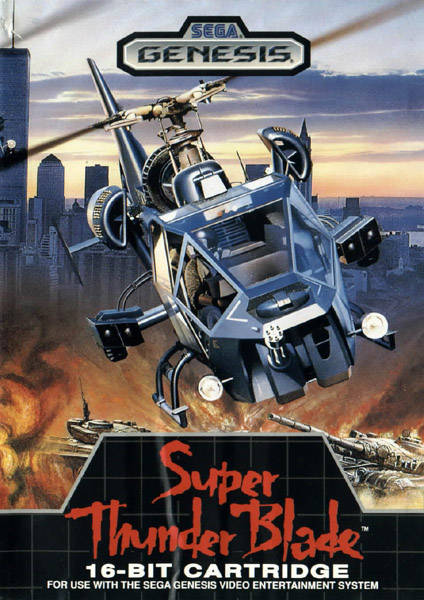
- Developer: Sega
- Publisher: Sega
- JP Release: 10/29/1988
- NA Release: 08/14/1989
- EU Release: 11/30/1990
- Franchise: Thunder Blade
- Genre: Shoot 'em up (Z-Axis)
- Theme: Modern Military
- Premise: The titular Thunder Blade is an advanced attack chopper, one that is given the responsibility of winning an entire war on its own.
- Availability: Appears in multiple Sega game compilations, including the Sega Genesis Collection (PS2 era), Sonic's Ultimate Genesis Collection (PS3 era), and Sega Genesis Classics (PS4 era). It's also on Wii Virtual Console.
- Preservation: Ditto with Space Harrier II, this was a revamped version of the original arcade Thunder Blade, with its less-than-super-scaler adaptation leaving something to be desired. I think Sega started with these two ports because they did at least look a lot better than anything the Master System or (importantly for their marketing department) the NES could produce. Super Thunder Blade's aged considerably worse than Space Harrier II, though, and doesn't have the same unconventional appeal.
003: Altered Beast/Juuouki
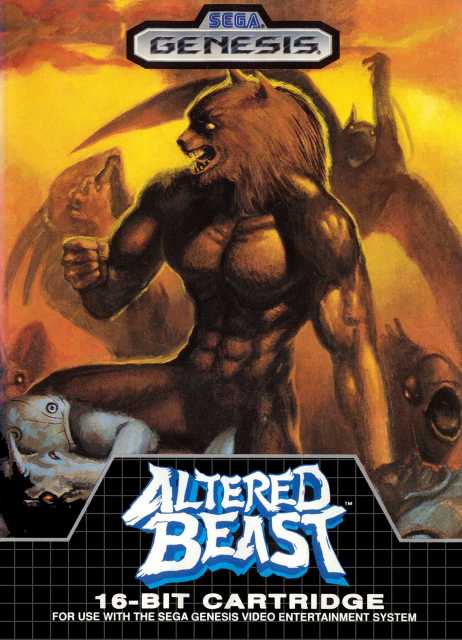
- Developer: Sega
- Publisher: Sega
- JP Release: 11/27/1988 (as Juuouki)
- NA Release: 08/14/1989
- EU Release: 11/30/1990
- Franchise: Altered Beast
- Genre: Brawler
- Theme: Fantasy/Ancient Roman
- Premise: A Roman centurion is resurrected by Zeus (surely Jupiter?) to rescue his daughter Athena (surely Minerva?) from Neff (this one seems OK). He does this by getting ripped, taking his shirt off, and changing into various beasts, long before DeviantArt made all that their purpose.
- Availability: Sega Genesis Collection, Sonic's Ultimate Genesis Collection, Sega Genesis Classics, a special 3D version for 3DS, and iOS and Wii Virtual Console ports.
- Preservation: Considered a classic of the brawler lineage, it's rudimentary and stiff by today's standards. However, it does at least vary things up across its five stages with all the beast transformations, each of which has their own unique attacks.
004: Osomatsu-kun: Hachamecha Gekijou
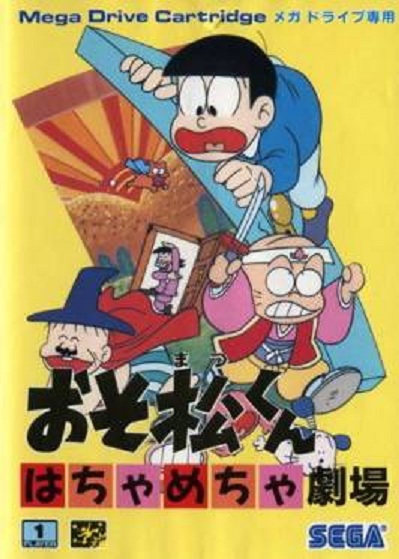
- Developer: Sega
- Publisher: Sega
- JP Release: 12/24/1988
- NA Release: N/A
- EU Release: N/A
- Franchise: Osomatsu-kun
- Genre: Platformer
- Theme: Comedy/Anime
- Premise: Osomatsu-kun finds himself in a strange fantasy world, and has to save his brothers from a group of familiar-looking bosses based on mythological creatures.
- Availability: Japanese Mega Drive only.
- Preservation: Osomatsu-kun the manga/anime has held up surprisingly well, given the evergreen slice-of-life premise of identical sextuplets who get into all sorts of scrapes at school and with their neighbors - it recently saw a reboot of sorts in 2015 as Mr. Osomatsu, which follows the six boys as adults and exhibits a more grown-up sense of humor. Osomatsu-kun the Mega Drive platformer, meanwhile, is a standard licensed quickie cash-in based on the popularity of the late-1980s anime adaptation by Studio Pierrot, though it does at least do right by the original mangaka Fujio Akatsuka with its big, colorful, and comedically expressive sprites. (Notably, Osomatsu-kun was the first wholly original Mega Drive game, not just a remastered arcade port, and the first to not be released outside of Japan.)
005: Alex Kidd in the Enchanted Castle/Alex Kidd: Tenkuu Majou
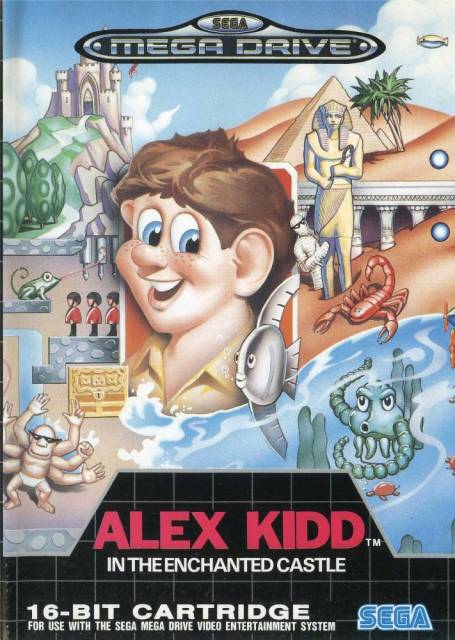
- Developer: Sega
- Publisher: Sega
- JP Release: 02/10/1989 (as Alex Kidd: Tenkuu Majou)
- NA Release: 08/14/1989
- EU Release: 1990
- Franchise: Alex Kidd
- Genre: Platformer
- Theme: Fantasy
- Premise: The janken-loving, big-eared idiot makes his way to Planet Paperock to visit the father he never knew existed. It's going to mean a lot of punching and arbitrary mini-games to reach him.
- Availability: Sega Genesis Collection, Sonic's Ultimate Genesis Collection, and the Sega Genesis Classics compilation (it's on Vol. 2 of the Steam version). It's also on Wii Virtual Console.
- Preservation: Even as one of the few people repping a Master System before ever touching a Mega Drive, I still don't care for this little dork, who for the longest time was Sega's mascot. One of the game's big flaws is a fascination with rock-scissors-paper, an inherently random "game" that will nevertheless kill you if can't defeat your opponent. The regular gameplay for Enchanted Castle is much like the Master System predecessors, with a lot of punching blocks for power-ups and money and the occasional Adventure Island-style vehicle section. None of that, nor its slightly stiff jumping, has held up all that well.
006: Phantasy Star II
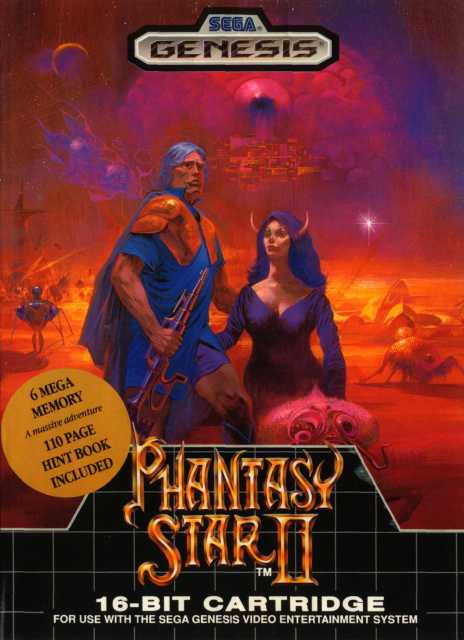
- Developer: Sega
- Publisher: Sega
- JP Release: 03/21/1989
- NA Release: March 1990
- EU Release: November 1990
- Franchise: Phantasy Star
- Genre: RPG
- Theme: Sci-fi
- Premise: Set one thousand years after the events of Phantasy Star, the Mega Drive sequel follows Agent Rolf, his mutant friend Nei, and a collection of other specialists as they attempt to topple the tyrannical rule of their star system's once-benevolent AI "Mother Brain".
- Availability: The usual places (Sega Genesis Collection, Sonic's Ultimate Genesis Collection, and the Sega Genesis Classics collection, part of Vol. 5 on the Steam version) as well as GBA and Saturn Phantasy Star compilations, Wii Virtual Console, and on XBLA.
- Preservation: I've never been able to break into these games; the early ones feel a bit primitive and I'm reluctant to play the later games in a series without completing their predecessors. Plus, I can never remember which ones are "the good ones". PS2 seems to have the best reputation, along with PS4, so maybe I'll give my Steam copies another go. From the outside looking in, there's a certain flatness to the graphics and its colors, but there's some nicely drawn anime-styled cutaways and portraits at least.
007: Tommy Lasorda Baseball/Super League
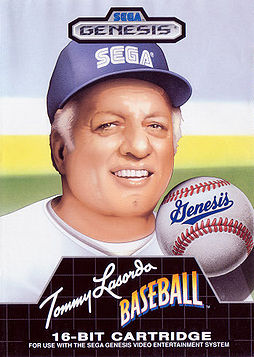
- Developer: Sega
- Publisher: Sega
- JP Release: 04/22/1989 (as Super League)
- NA Release: 10/06/1989
- EU Release: 1990 (as Super League)
- Franchise: N/A
- Genre: Baseball
- Theme: Pro Sports
- Premise: Run the bases and win the World Series in this baseball game endorsed by the then-manager of the LA Dodgers.
- Availability: Mega Drive only.
- Preservation: Like any sport, there's incremental progress to the realism of the game in each successive console generation, and sometimes even between years. Unless you're a really anally retentive expert of the history of sports games, there's not a lot to separate all the 16-bit versions of America's favorite pastime, beyond the visual style and whether or not they retain the real team and player names. This one doesn't seem awful - it's unlikely Lasorda would've lent his name to it otherwise, though I suppose a big stack of money talks louder than video game footage for most major figures in the sports world - but I'd find it hard to pick out of a crowd, especially with how many baseball games there were for the SNES and Mega Drive.
008: Super Daisenryaku
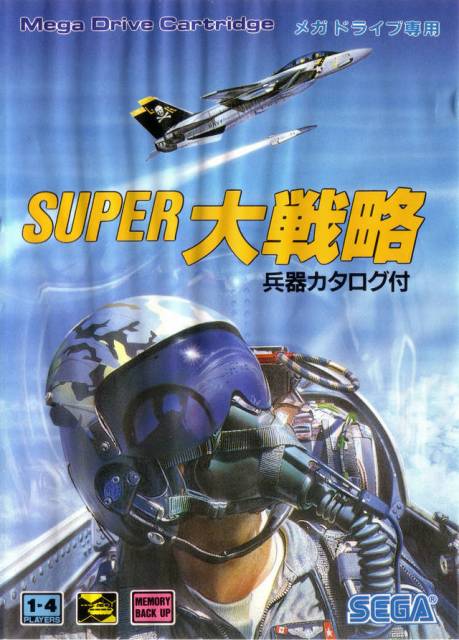
- Developer: Systemsoft
- Publisher: Sega
- JP Release: 04/29/1989
- NA Release: N/A
- EU Release: N/A
- Franchise: Daisenryaku
- Genre: Strategy (Turn-Based)
- Theme: Modern Military
- Premise: Win various important battles across recent wartime history with the first 16-bit game in the long-running Daisenryaku ("Great Strategy") series.
- Availability: Japanese Mega Drive only.
- Preservation: The Daisenryaku franchise is a serious strategy-sim series made for hobbyists, full of detailed recreations of various military vehicles and their relative strengths. It's also completely in Japanese, as the second of our non-international Mega Drive releases. That's two layers of incomprehensibility I'm unlikely to ever navigate through. Still, there's a distinct Military Madness/Advance Wars vibe to the hexagonal look, allied units with the same uniform bright color, and cutaway battles that I sort of like.
009: Thunder Force II
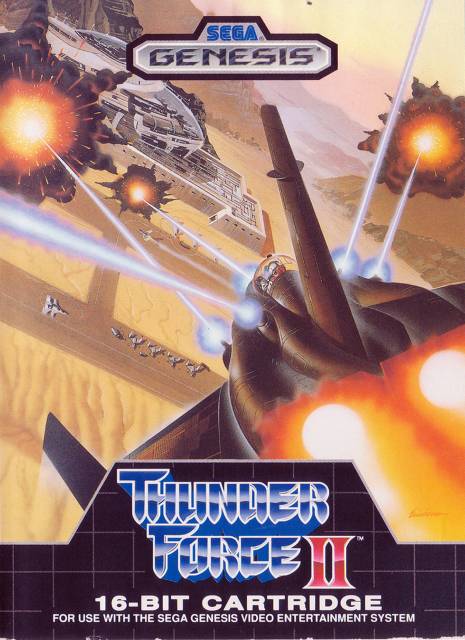
- Developer: Technosoft
- Publisher: Sega
- JP Release: 06/15/1989
- NA Release: 08/14/1989
- EU Release: September 1990
- Franchise: Thunder Force
- Genre: Shoot 'em up.
- Theme: Sci-fi.
- Premise: The Thunder Force series comes to consoles for its first sequel. The ORN Empire needs putting down once again by the Galaxy Federation and their state-of-the-art attack ship, the Fire Leo.
- Availability: Besides the Genesis version, there's the original X68000 version and a Saturn compilation that grouped 2 and 3 together (but was only released in Japan).
- Preservation: It's another shoot 'em up and another NA Genesis launch game, though this one's a little different in how it varies between top-down and side-scrolling look. The top-down parts of the game are also fairly open: you can go in all four directions, hunting down these big flashing bases to blow up. The side-scrolling segments are a little more traditional. It's another early Mega Drive game that makes use of the system's parallax scrolling - the big tech advantage the system had over its rivals - though the original version of the game, for the X68000 home computer, is purportedly the better-looking one. I just recall getting annoyed at the various barriers you had to destroy in the top-down sections, because they came at you really fast when flying around.
010: Last Battle/Hokuto no Ken: Shin Seikimatsu Kyuuseishu Densetsu
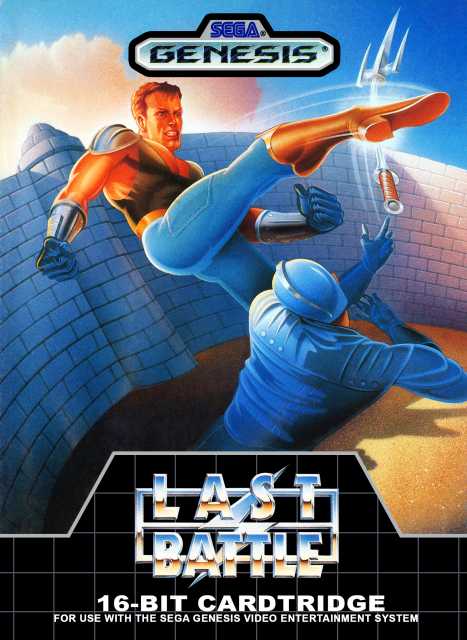
- Developer: Sega
- Publisher: Sega
- JP Release: 07/01/1989 (as Hokuto no Ken: Shin Seikimatsu Kyuuseishu Densetsu)
- NA Release: 1989
- EU Release: 1990
- Franchise: Hokuto no Ken/Fist of the North Star
- Genre: Brawler
- Theme: Post-Apocalyptic/Anime
- Premise: A lone man wanders the wastelands of a post-apocalyptic Earth, equipped with a strong sense of justice and an even stronger fighting style that can cause his opponents' heads to explode. His name... is Aarzak?
- Availability: Besides the original Genesis cart, it's also available on Wii Virtual Console (but only in Japan).
- Preservation: I'm not sure there's ever been a good Hokuto no Ken game, which is odd because the premise is almost custom-built for an excellent brawler. Something about it being an anime license that could coast on name recognition made every adaptation automatically half-assed, I suppose. Anyway, this Mega Drive also-ran definitely isn't the hulking mysterious champion this franchise was looking for to save it, and changing everyone's names and removing the gore for the NA/EU versions didn't help.
011: World Championship Soccer/World Cup Italia '90/World Cup Soccer
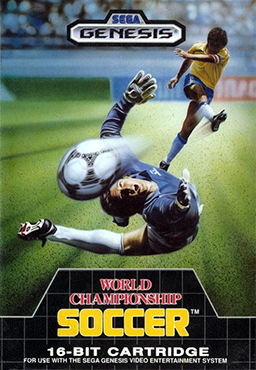
- Developer: Sega
- Publisher: Sega
- JP Release: 07/29/1989 (as World Cup Soccer)
- NA Release: September 1989
- EU Release: 1990 (as World Cup Italia '90)
- Franchise: N/A
- Genre: Soccer
- Theme: Pro Sports
- Premise: Take on the world's best teams in this World Cup inspired soccer game from Sega. We've already had a Baseball game, so a Soccer game was sure to follow.
- Availability: Mega Drive/Genesis only.
- Preservation: I might say that the only historical virtue to World Championship Soccer, which is otherwise a dull and unremarkable soccer game, is that it recreates the 1990 World Cup hosted by Italy, at least for its slightly late European version. However, this game was developed before the qualifiers had finished, so it had to guess what the final teams would be and missed the mark considerably. So, no, unless you're such a fanatic of the sport that you need to collect every virtual approximation, there's not a whole lot here that's worth revisiting.
012: Ghouls 'N Ghosts/Daimakaimura
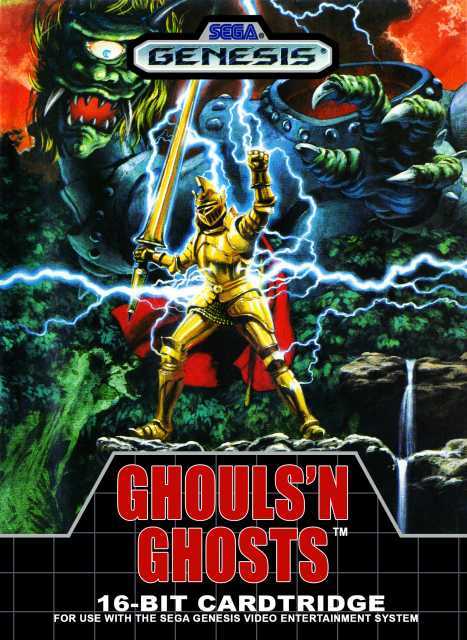
- Developer: Capcom
- Publisher: Sega
- JP Release: 08/03/1989 (as Daimakaimura)
- NA Release: 1989
- EU Release: 11/30/1990
- Franchise: Ghosts 'N Goblins
- Genre: Platformer
- Theme: Horror
- Premise: Arthur has to recover the beautiful Princess Prin-Prin's soul from Lucifer in the second game in the Ghosts 'n Goblins franchise.
- Availability: It's a fairly major 16-bit Capcom game, so it showed up in a number of "Capcompilations", including Capcom Generations and Capcom Classics Collection Vol. 1. The Genesis version was also made available on Wii Virtual Console.
- Preservation: Despite the modern gaming audience's propensity for really tough games in a gothic horror type of setting, the various "G-word 'N G-word" games were really too annoyingly difficult for me to have the same lasting power as Capcom's many other games from this era, like Mega Man (which was difficult, but not overly so) and Bionic Commando. That said, I always loved this series' music and look, cutting through the creepiness with the goofy (and unfortunately frequent) sight of Arthur in his boxers. I had a lot more familiarity with Super Ghouls'n Ghosts, of course, but I suspect this was probably the better iteration.
013: Arnold Palmer Tournament Golf/Ozaki Naomichi no Super Masters
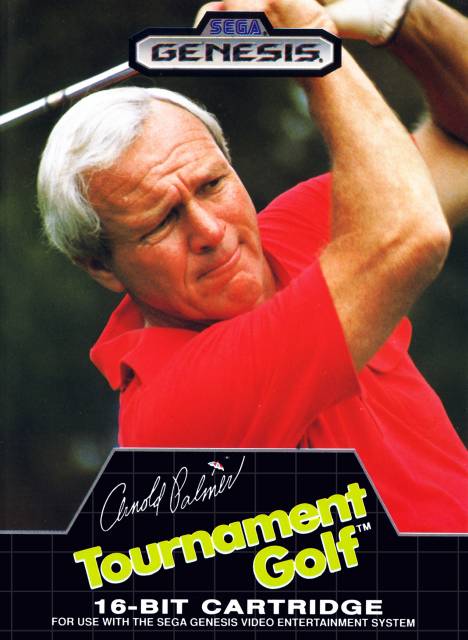
- Developer: Sega
- Publisher: Sega
- JP Release: 09/09/1989 (as Ozaki Naomichi no Super Masters)
- NA Release: 1989
- EU Release: 1990
- Franchise: N/A
- Genre: Golf
- Theme: Pro Sports
- Premise: The first golf game for the Mega Drive, this one's full of cute little Sega references but not a whole lot else. I mean, besides Arnold Palmer. Isn't that a drink?
- Availability: Mega Drive/Genesis only.
- Preservation: Whee, golf. I don't know about anyone else, but I tend to really like golf games when they don't play like normal golf games - Mario Golf, Kirby's Dream Course, Ribbit King, et al - and get kinda bored quick when they do. Still, of all the sports genres, golf is usually the least objectionable. All that said, there's nothing beyond the endorsement that makes this game stand out, besides the Fantasy Zone bonus level that appears if you take 100 shots on the same hole (it tickles me that someone had to have found that accidentally, and man were they having a bad day).
014: Super Hang-On
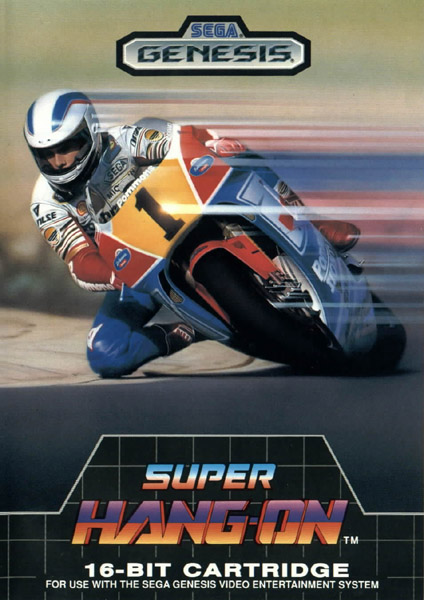
- Developer: Sega
- Publisher: Sega
- JP Release: 10/06/1989
- NA Release: 10/06/1989
- EU Release: 1990
- Franchise: Hang-On
- Genre: Driving
- Theme: Motorsports
- Premise: Ride a motorcycle through race courses across the world in this console adaptation of Sega's super-scaler motorsports classic.
- Availability: Super Hang-On's a weird case, because the Genesis version doesn't appear in many Sega compilations. However, if you're looking for the arcade version, you have a Wii Virtual Console port, a version available on PS3's PSN marketplace, and you can also play it in Yakuza 0 via the Sega Hi-Tech Land arcade. (The original Hang-On, meanwhile, is available in the first Shenmue.)
- Preservation: Arcade racers always have a certain timelessness, because realism isn't always important for enjoying a game like Super Hang-On. That said, I tend to tire of these games relatively quickly. The Genesis version has a story mode of sorts, where you earn money from racing to upgrade your bike, but early on it's really hard going with your unadorned junker. You have to lose a lot of races (and get paid anyway) before you can hope to compete.
015: Super Hydlide
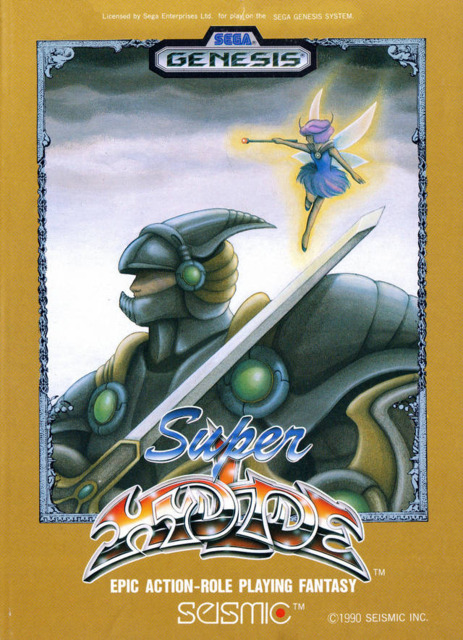
- Developer: T&E Soft
- Publisher: Asmik/Seismic/Sega
- JP Release: 10/06/1989
- NA Release: April 1990
- EU Release: 1991
- Franchise: Hydlide
- Genre: Action-RPG
- Theme: Fantasy
- Premise: T&E's "run into enemies to hurt them" RPG series is back with the third entry, which was dubbed Super Hydlide for its enhanced Mega Drive port. Certainly have been a lot of "Super" games and very few "Mega" games for Mega Drive so far...
- Availability: Mega Drive/Genesis only.
- Preservation: I'd argue that no Hydlide game has aged particularly well, but Super Hydlide does make a spirited attempt to stand out with its unusual "morality" gauge, that keeps track of lousy decisions the player makes, as well as advanced-for-its-time features like a day/night cycle (and, alas, weight encumbrance).
016: Rambo III
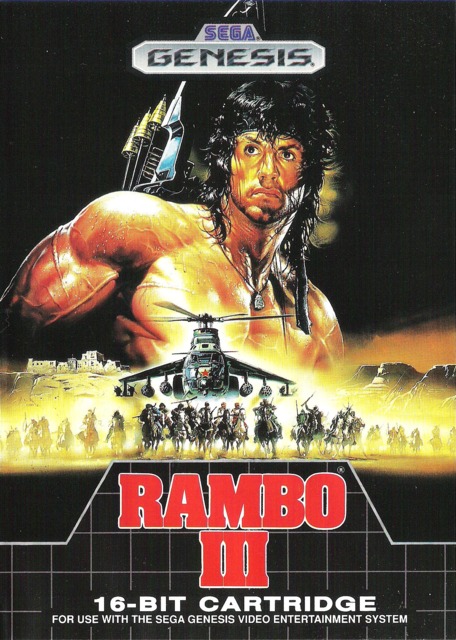
- Developer: Sega
- Publisher: Sega
- JP Release: 10/21/1989
- NA Release: 1989
- EU Release: September 1990
- Franchise: Rambo
- Genre: Shooter
- Theme: Modern Military
- Premise: This is the Rambo that's set during the Gulf War. A little bit dated by today's standards, especially the part where Rambo throws his lot in with the Taliban. Hey, the 80s was a different time. Anyway, you shoot lots of stuff.
- Availability: A bunch of other home versions, but nothing lately. Well, besides that awful rail shooter from 2014.
- Preservation: The Rambo III game isn't all that bad, surprisingly for an American movie tie-in, but it does drag a bit, especially in the maze-like levels where you're looking for prisoners or some other multiple targets. There's a few places where it feels a little ahead of its time, even: the knife, the worst weapon to use to kill soldiers, will reward you with ammo for your better weapons: this gives you a reason to use it, and also a way to replenish valuable ammo you must be pretty low on if you're resorting to the knife, which is more or less what the new Doom does with the chainsaw. However, I wouldn't argue that it's stood the test of time too well almost 30 years on.
017: Zoom!
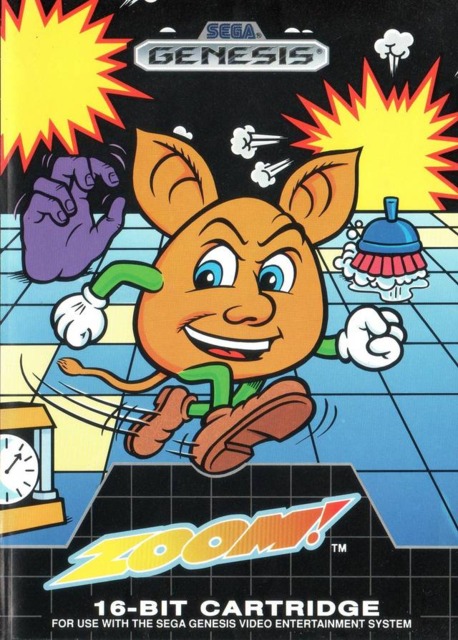
- Developer: Cyclone Software
- Publisher: Sega
- JP Release: 01/03/1990
- NA Release: 11/03/1989
- EU Release: 1990
- Franchise: N/A
- Genre: Puzzle
- Theme: Abstract
- Premise: A weird orange thing with elf ears skates across an abstract wireframe Tron grid, completing squares as he goes. It's one of those bizarre abstract puzzle games inspired by the likes of Q*Bert, Pac-Man, and (possibly) Skweek. This game's page wins the dubious distinction of requiring the most work to get it into shape.
- Availability: Mega Drive/Genesis cart only, unless you want to track the original Amiga version down.
- Preservation: Most people would point to Columns as the original Sega Mega Drive puzzle game, as iconic as it became as Sega's answer to Tetris, but actually the first one was this really weird throwaway Amiga platformer. It started a trend that would help make the Mega Drive a force to be reckoned with in Europe and Australia: Amiga ports out the wazoo, frequently converting games that never saw console ports on anything else. In pure mechanical terms, it's a cute early puzzle game that gets rote fairly quickly. Plus the grating cocky voice samples from your elfin blob hero doesn't help its case.
018: Forgotten Worlds
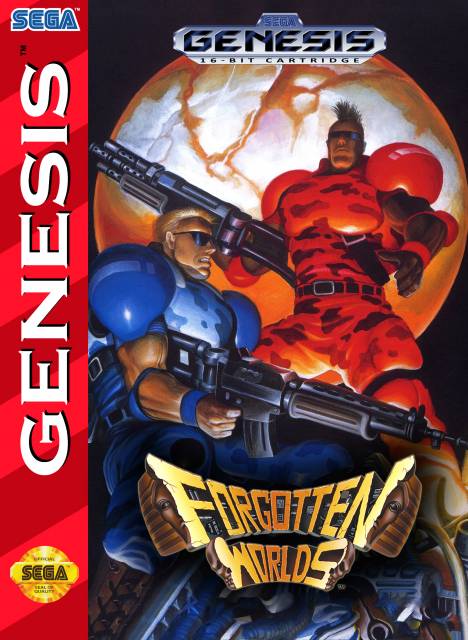
- Developer: Sega
- Publisher: Sega
- JP Release: 11/18/1989
- NA Release: 11/17/1989
- EU Release: 1990
- Franchise: N/A
- Genre: Shoot 'em up
- Theme: Sci-fi? It's hard to tell.
- Premise: Two Schwarzenegger lookalikes grab matching jetpacks and take off across a series of bizarre levels to take down Emperor Bios before he can reboot the universe directly to the system firmware and, I dunno, mess with the keyboard settings.
- Availability: The arcade version made it to some Capcompilations, but for the Mega Drive version it's either the original cart or the Wii Virtual Console release from ten years ago. There's also a TurboGrafx-CD release, if a version with CD audio is more to your liking.
- Preservation: I think I played this for five minutes before crashing and burning, because it controls like so much ass. The original arcade version had a unique set-up where each player had a joystick for movement and a rotating knob for firing. Capcom's improvized solution for the Mega Drive version (and this might also be true for the TGCD version, I forget) was to dedicate two of the face buttons to turning your projectile stream clockwise and counter-clockwise. It's... well, let's just say the arcade version was barely playable, and that it fares a lot worse on the Mega Drive. Still, it all looks completely nuts if you like a shoot 'em up with some personality to it.
019: Mystic Defender/Kujaku Ou 2: Geneijou
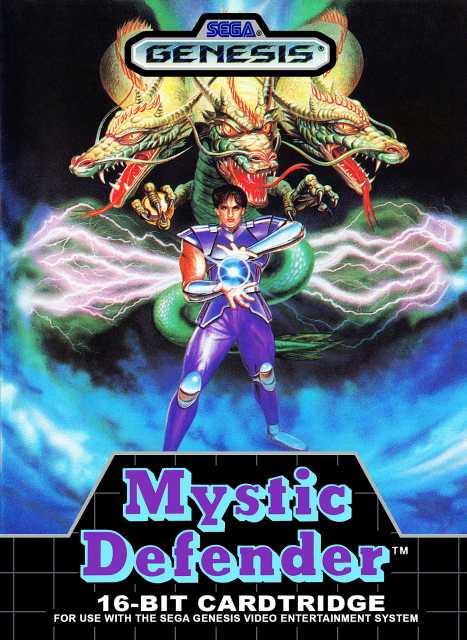
- Developer: Sega
- Publisher: Sega
- JP Release: 11/25/1989 (as Kujaku Ou 2: Geneijou)
- NA Release: 1989
- EU Release: 1990
- Franchise: Kujaku Ou
- Genre: Platformer
- Theme: Fantasy
- Premise: An evil god has shown up, and it's up to Joe Yamato (why are these guys always named Joe?) to head to its castle to blow it up with fireballs, maybe saving a woman along the way. Another anime license whitewashed for an international audience.
- Availability: Mega Drive/Genesis cart only.
- Preservation: This actually seemed kind of fun when I played it. It's a bit like Shinobi if the ninja magic was all you had, and the game pulls a Legendary Axe by making you charge each spell up to maximize its damage and range. Subsequent spells have different areas of effect - the fireball spell, which you pick up just before the first boss, creates a low-range flamethrower that can be aimed up and down, which makes it great against enemies on stairs or different elevations. One of those cool, lesser-known games I was hoping to bump into with this Wiki Project.
020: The Revenge of Shinobi/The Super Shinobi
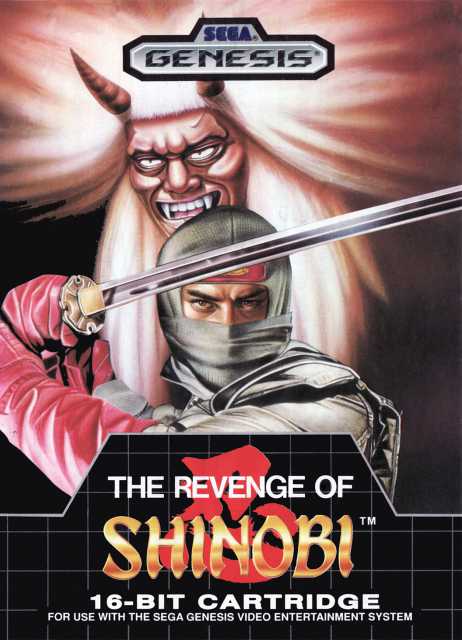
- Developer: Sega
- Publisher: Sega
- JP Release: 12/02/1989 (as The Super Shinobi)
- NA Release: 12/02/1989
- EU Release: 1990
- Franchise: Shinobi
- Genre: Action
- Theme: Ninjas
- Premise: Joe Musashi, the world's busiest ninja, is forced into action once again when the evil criminal organization Zeed returns as Neo Zeed, kills his master, and kidnaps his fianceé. Worst of all, Zeed seems to have brainwashed Spider-Man, Batman and the Incredible Hulk.
- Availability: There's a Wii Virtual Console release, a PS3 digital release, a XBLA release, and it also appears on the most recent Sega compilation, Sega Genesis Classics (it was part of Vol. 5 on Steam).
- Preservation: Revenge is the best Shinobi or, depending on who you ask, the one good Shinobi. They started leaning more into the ninja magic for this one, and it has some decent level design and graphics, but it can also be tough for no good reason; there's off-screen enemy attacks that are impossible to anticipate, and a whole lot of insta-kill obstacles to avoid.
